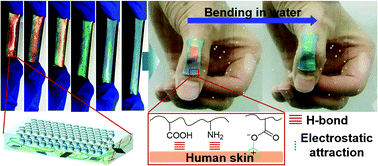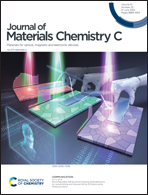A biocompatible, self-adhesive, and stretchable photonic crystal sensor for underwater motion detection†
Abstract
Smart wearable visual sensors are promising in many areas such as motion monitoring and interactive devices. However, the realization of both biocompatibility and self-adhesiveness simultaneously for direct wearing remains challenging. Herein, a biocompatible photonic crystal (PC) sensor based on a combination of a self-adhesive hydrogel, a close-packed polymethylmethacrylate (PMMA) nanoparticle array, and uniformly dispersed graphene is presented. This sensor exhibits excellent self-adhesion (≈27 kPa to the human skin), stretchability (≈1050%), color variability (from red to blue, ≈2.09 nm%−1), and mechanoelectrical properties, allowing it to directly adhere to the human skin to monitor local deformation via optical and electrical signals simultaneously. Moreover, its adhesion to the human skin is quite stable even after soaking or flushing with water where its maximum tolerable flow rate is approximately 2.1 m s−1. This PC sensor has great potential for the real-time monitoring of body motion in some sports such as swimming and diving, and may find more applications in wearable devices and strain sensors.



 Please wait while we load your content...
Please wait while we load your content...